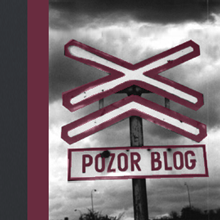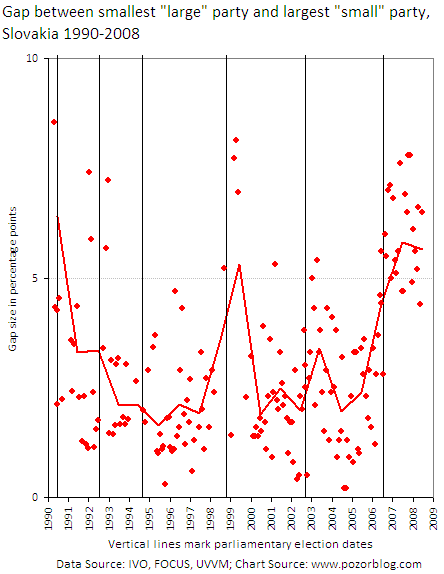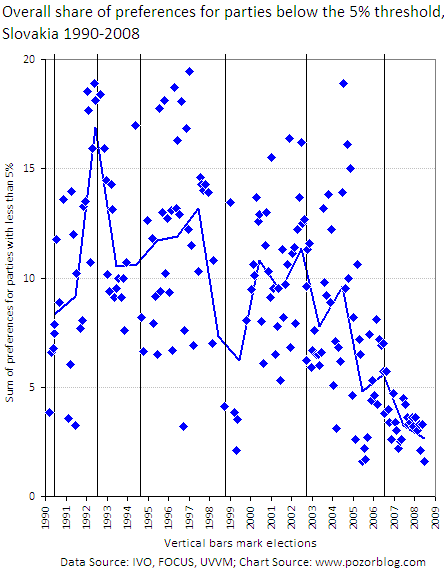Trends and comparisons monthly report
Inside the averages are multiple polls using slightly different methods and samples. When put together these yield a surprisingly smooth and consistent picture that is the most useful for assessing levels and trends, but it is useful to take them apart from time to time to discern any internal shifts and to assess the work of the pollsters whose efforts combine to make the overall average.
Between June and September we had one month with only one poll (July) and one with only two (August), so the most useful baseline comparison here are the first and last entries for each poll.
For Smer the story is consistent over time. Among FOCUS respondents Smer achieved a near-record high in the June survey; among UVVM respondents the high came in the July survey and as always it was considerably higher than Smer numbers in the other surveys. We do not have MVK for this period but Smer almost invariably polls lower for MVK (nearer to FOCUS-levels) than for UVVM. Over time UVVM numbers show stability around 46%, while FOCUS shows a decline from around 44% to around 39% and MVK shows a rise from 39% to 41%, meaning that the overall shift is slightly downward.

The SDKU graph is rather striking and shows an unusual pattern: near unanimous agreement between the three pollsters in June and August followed by almost the same mean in September composed of divergent estimates (FOCUS, as usual on the high side, UVVM as usual on the low side and MVK, as usual (for both SDKU and Smer) near the mean.

Results for SNS show a shocking degree of consistenc. All three polls remained within a single point and showed the exact same pattern: a rise between June and August followed by a decline below June levels in September. This kind of univocality is really quite.

But just when the polls were looking consistent, results for MK give us reason for taking any estimate with a large grain of salt: Of all parties it is the Hungarian Party’s almost exclusively ethnic base that should yield the most consistent answers and yet UVVM numbers for September tend to wander around more than for other, non-ethnic parties, this month dropping below 7%. This is highly unlikely and appears to reflect a long-term problem on the part of UVVM to get the ethnic samples consistent. The Hungarian ethnic population is stable, and the overall averages for MK are quite stable (though showing a long term pattern of decline) so MK’s numbers should be relatively stable as well and for UVVM they simply are not. This, of course, raises questions about how other sampling questions could be affecting other parties’ results (for any of the polls, not just UVVM) and suggests the importance of looking at multiple polls. As it is averaged here, MK remains stable at just above 9%.

Similar problems emerge with regard to HZDS. All three polls agreed on a level of 8%-9% in June but have since diverged, with FOCUS and UVVM show a drop to around 7% while UVVM alone shows a rise to arund11%. This is a divergence of nearly 50% on an average support of 8% and something is clearly wrong here. It is not clear what, but a facile decision by majority rule suggests that the problem may lie with HZDS. Given the inconsistencies, it would not be surprising to see the party’s preferences in the UVVM survey fall back to around 9% in October.

With KDH there is simply not much to say. As with SNS, the polls tend to agree and show the same patterns over time. Here, however, the pattern is absolute stability around 9%. This is what one would expect of a “demographic” population rather than the variations in MK seen above.

For the smaller parties it is always more difficult to gauge, but KSS remains stable around 2% (FOCUS and UVVM show a slight overall rise, MVK shows a drop, but the June MVK number was a recent-record-high for MVK and may have been an outlier in the first place.

SF, too, hovers around 2%, and from June to September shows almost no change in any of the three polls, though they disagree among themselves whether the party is closer to 1% (UVVM) or 3% (FOCUS)

There are some issues that I realize I am not dealing with in these analyses, particularly support for the Green Party (SZ) which is included in the questioner list only by MVK, and the question of non-voters, which is worthy of attention and should become a topic of future monthly and quarterly graphs.



